Introduction to Moroccan Cuisine
Moroccan cuisine is a captivating blend of flavors, spices, and cooking techniques that have been influenced by a rich history of trade and cultural exchange. It is a culinary tradition that reflects the diverse geography and cultural heritage of the North African country. With its tantalizing aroma, vibrant colors, and harmonious combination of ingredients, Moroccan cuisine has gained international recognition for its unique and distinctive flavors.
One of the defining characteristics of Moroccan cuisine is the extensive use of spices. From the fiery heat of cumin and paprika to the exotic fragrances of cinnamon and saffron, spices play a pivotal role in creating the complex and varied flavors that are synonymous with Moroccan dishes. These aromatic spices infuse every dish with a depth of flavor that is both enticing and delectable.
Another notable aspect of Moroccan cuisine is the diversity of its dishes. From hearty tagines to flavorful couscous, the variety of Moroccan dishes is simply astounding. This diversity is a result of the country's geographic location and historical connections to neighboring countries, such as Spain, France, and the Middle East. Each region of Morocco has its own culinary specialties, which reflect the local ingredients and cultural influences.
In Moroccan cuisine, ingredients are carefully selected and combined to create harmonious flavor profiles. The use of fresh, locally sourced produce is emphasized, with vegetables, fruits, and herbs playing a prominent role in many dishes. From the sweet and juicy dates to the tangy preserved lemons, each ingredient brings its own unique flavor to the table.
Key Ingredients in Moroccan Cuisine
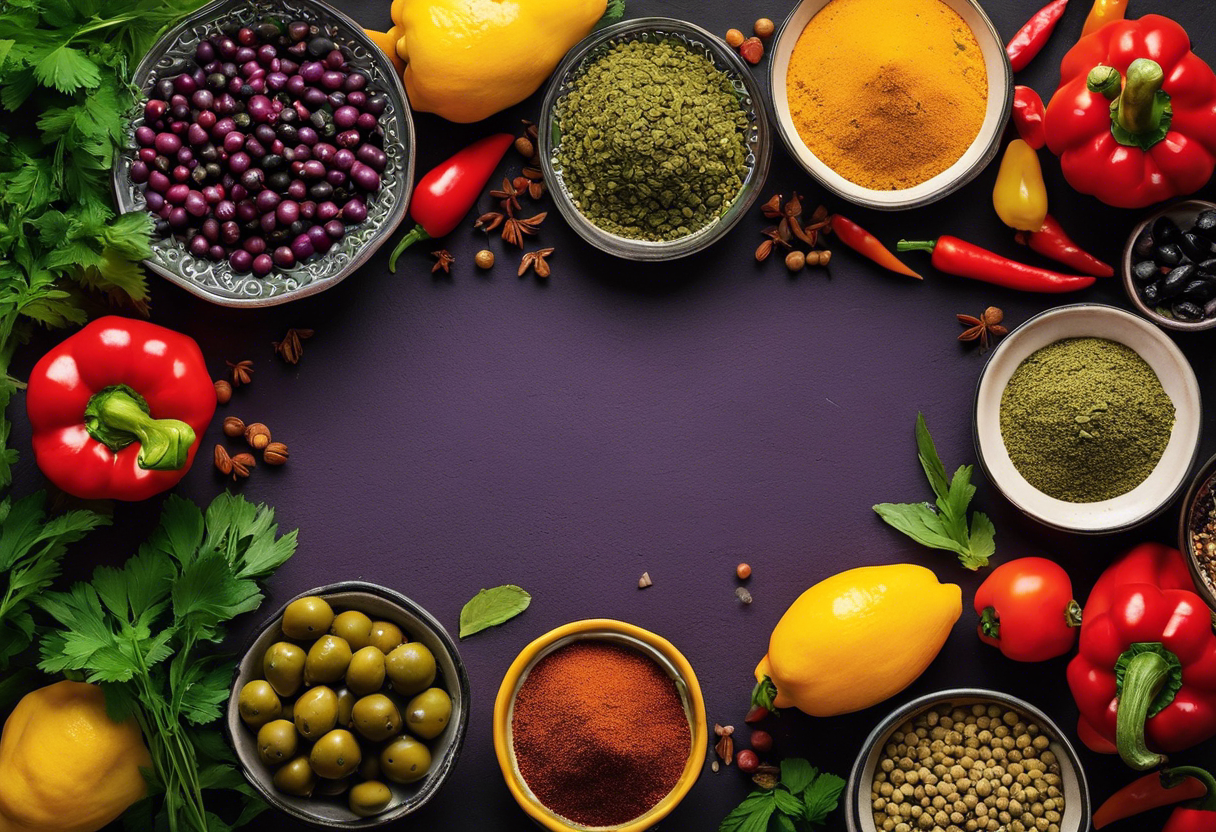
Moroccan cuisine is renowned for its bold and vibrant flavors, which are derived from a unique blend of spices, herbs, and other key ingredients. These ingredients contribute to the distinct taste and aroma that characterizes Moroccan dishes. Here are some key ingredients commonly found in Moroccan cuisine:
- Spices: Spices are the heart and soul of Moroccan cooking. The most prominent ones include cumin, coriander, cinnamon, ginger, turmeric, paprika, and saffron. These spices add depth, warmth, and complexity to dishes, creating a harmonious balance of flavors.
- Herbs: Fresh herbs are an essential component of Moroccan cuisine. Parsley, cilantro, and mint are frequently used to add freshness and brighten up dishes. They are often added at the end of cooking or used as a garnish to add a burst of herbaceous flavor.
- Preserved lemons: Preserved lemons are a staple in Moroccan cooking. They are made by pickling lemons in a brine solution and are used extensively in dishes such as tagines and couscous. The preserved lemons impart a tangy and slightly salty flavor that enhances the overall taste of the dish.
- Olives: Olives are a common ingredient in Moroccan cuisine, particularly in salads, stews, and tagines. They add a salty tang to dishes and provide a contrasting texture.
- Argan oil: Argan oil is a unique and highly prized ingredient in Moroccan cooking. It is made from the nuts of the argan tree, which is native to Morocco. This flavorful oil is used as a dressing, dip, or added to dishes for a rich and nutty taste.
- Harissa: Harissa is a spicy chili paste that is widely used in Moroccan cuisine. Made from chili peppers, garlic, cumin, and other spices, it adds heat, depth, and intense flavor to dishes. Harissa is often served as a condiment or used as a marinade for meat and poultry.
- Couscous: Couscous is a staple grain in Moroccan cuisine. Made from semolina, it is fluffy, light, and serves as a versatile base for various dishes It is often steamed and served alongside stews or tagines, absorbing their flavors.
- Dates and almonds: Dates and almonds are commonly used in Moroccan desserts and sweet dishes. The sweetness of dates and the nuttiness of almonds add richness and texture to indulgent treats like pastries, cookies, and puddings.
Popular Moroccan Dishes
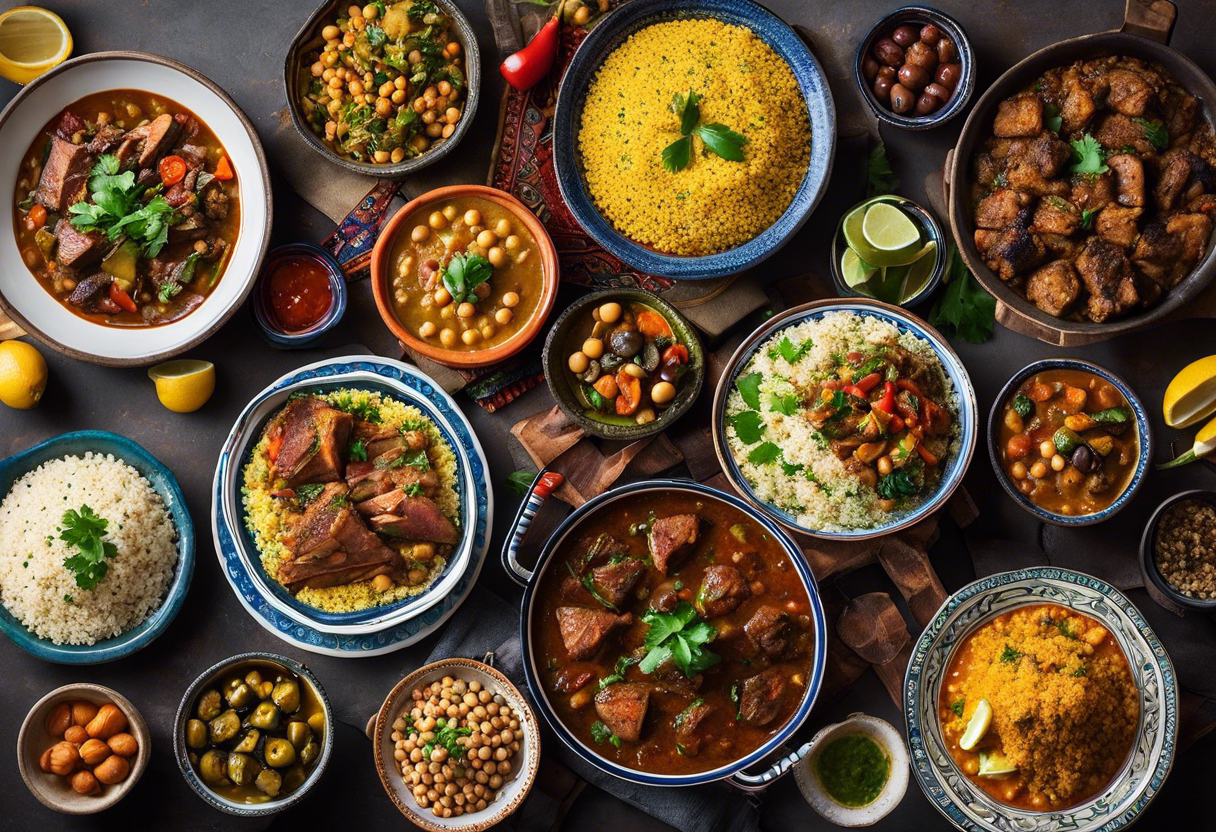
Moroccan cuisine is known for its rich and diverse flavors, combining various spices, meats, vegetables, and grains. Here are some popular Moroccan dishes that you must try:
- Tagine: This is perhaps the most well-known Moroccan dish. It is a slow-cooked stew made with meat (such as lamb or chicken), vegetables, and a variety of spices. The stew is cooked in a traditional clay pot called a tagine, which gives the dish its name.
- Couscous: Couscous is a staple in Moroccan cuisine. It is made from semolina grains and is typically served with meat and vegetables. The couscous is steamed to perfection, resulting in a fluffy texture that perfectly complements the flavors of the dish.
- Pastilla: This is a delicious and savory Moroccan pastry. Pastilla is made with layers of flaky pastry dough filled with a mixture of shredded chicken, almonds, and spices. It is then dusted with powdered sugar and cinnamon, adding a unique combination of sweet and savory flavors.
- Harira: Harira is a traditional Moroccan soup commonly served during Ramadan. It is made with a hearty blend of lentils, beans, tomatoes, and meat (usually lamb). It is flavored with various spices, including ginger, turmeric, and cinnamon, giving it a distinctive taste.
- Briouats: Briouats are small, triangular pastries filled with a variety of ingredients. They can be stuffed with meat, cheese, vegetables, or a combination of these. They are typically deep-fried until golden and crispy, making them a popular choice for an appetizer or snack.
- Merguez: Merguez is a type of spicy sausage made from lamb or beef. It is flavored with a mixture of spices such as paprika, cumin, and chili pepper. Merguez sausages are often grilled or pan-fried and are commonly served with bread or as part of a couscous dish.
- Zaalouk: Zaalouk is a flavorful Moroccan eggplant salad. The eggplants are roasted until tender and then mashed with tomatoes, garlic, and a blend of spices. The salad is served cold or at room temperature and is often enjoyed as a side dish or a dip with bread.
- Mechoui: Mechoui is a traditional Moroccan lamb dish that is typically prepared for special occasions. The lamb is slow-roasted over an open fire or in a clay oven, resulting in tender and flavorful meat. It is often seasoned with a blend of spices and served with bread and mint tea.
- Mint Tea: Mint tea, also known as "Moroccan whiskey," is a staple beverage in Morocco. It is made with green tea leaves, fresh mint leaves, and sugar. The tea is typically served in small glasses and is known for its refreshing and fragrant taste.
These are just a few examples of the many delicious dishes that make up Moroccan cuisine. Each dish offers a unique blend of flavors, spices, and ingredients that showcase the rich culinary heritage of Morocco. Whether you're a fan of hearty stews, flavorful pastries, or aromatic teas, exploring the flavors of Moroccan cuisine is sure to be a delightful experience.
The Role of Spices in Moroccan Cuisine

Spices are an essential aspect of Moroccan cuisine, adding depth, complexity, and a unique flavor profile to the dishes. Moroccan cooking is renowned for its bold and aromatic use of spices, which elevate simple ingredients to new heights of deliciousness. These spices not only provide incredible taste but also have numerous health benefits.
- Cumin: Cumin is a staple spice in Moroccan cooking. It is used in a variety of dishes, from tagines to couscous. The warm and earthy flavor of cumin adds depth and richness to Moroccan dishes, amplifying their taste and aroma.
- Coriander: Coriander seeds are commonly used in Moroccan cuisine. They have a slightly citrusy and floral flavor, which pairs well with the other spices. Ground coriander is often found in spice blends and is a key component in creating the unique Moroccan taste.
- Paprika: Paprika adds a vibrant red color and a mild, sweet flavor to Moroccan dishes. It is used in a variety of recipes, including spice rubs, tagines, and stews. The smoky and earthy undertones of paprika enhance the overall taste and appearance of Moroccan cuisine.
- Turmeric: Known for its vibrant yellow color, turmeric is used in Moroccan cooking for both its flavor and health benefits. The warm and slightly bitter taste of turmeric complements dishes like tagines and rice-based dishes. Additionally, it is known for its anti-inflammatory properties.
- Cinnamon: Cinnamon is an important spice in Moroccan cuisine, often used in both sweet and savory dishes. Its warm and fragrant flavor adds a unique complexity to tagines, couscous, pastries, and teas. Cinnamon is also believed to have various health benefits, such as improving digestion and blood sugar control.
- Ginger: Ginger brings a spicy and pungent flavor to Moroccan dishes. It is commonly used in marinades, sauces, and desserts, providing a zesty kick. In addition to its distinctive taste, ginger is renowned for its anti-inflammatory and digestive properties.
- Saffron: Saffron, one of the most expensive spices in the world, is highly treasured in Moroccan cuisine. Its subtle floral flavor and vibrant yellow color make it a prized ingredient in dishes like tagines and rice pilafs. Saffron adds an element of luxury to Moroccan culinary creations.
- Ras el Hanout: Ras el Hanout is a Moroccan spice blend that typically contains a combination of various spices, including cardamom, clove, nutmeg, allspice, and more. It is a versatile and complex seasoning that is used in a wide range of dishes, adding layers of flavor and aroma.
The use of spices in Moroccan cuisine goes beyond flavor enhancement. Many spices have medicinal properties and are used for their health benefits. For example, turmeric and ginger are known for their anti-inflammatory properties, while cinnamon is believed to aid digestion.
In Moroccan culture, spices hold significant cultural and culinary value. Their aromatic and distinct flavors are intertwined with the vibrant tapestry of Morocco's culinary heritage. The skillful use of spices allows Moroccan dishes to transport diners to the bustling souks and busy kitchens of Morocco, where a world of flavors awaits.
The Influence of Geography on Moroccan Cuisine
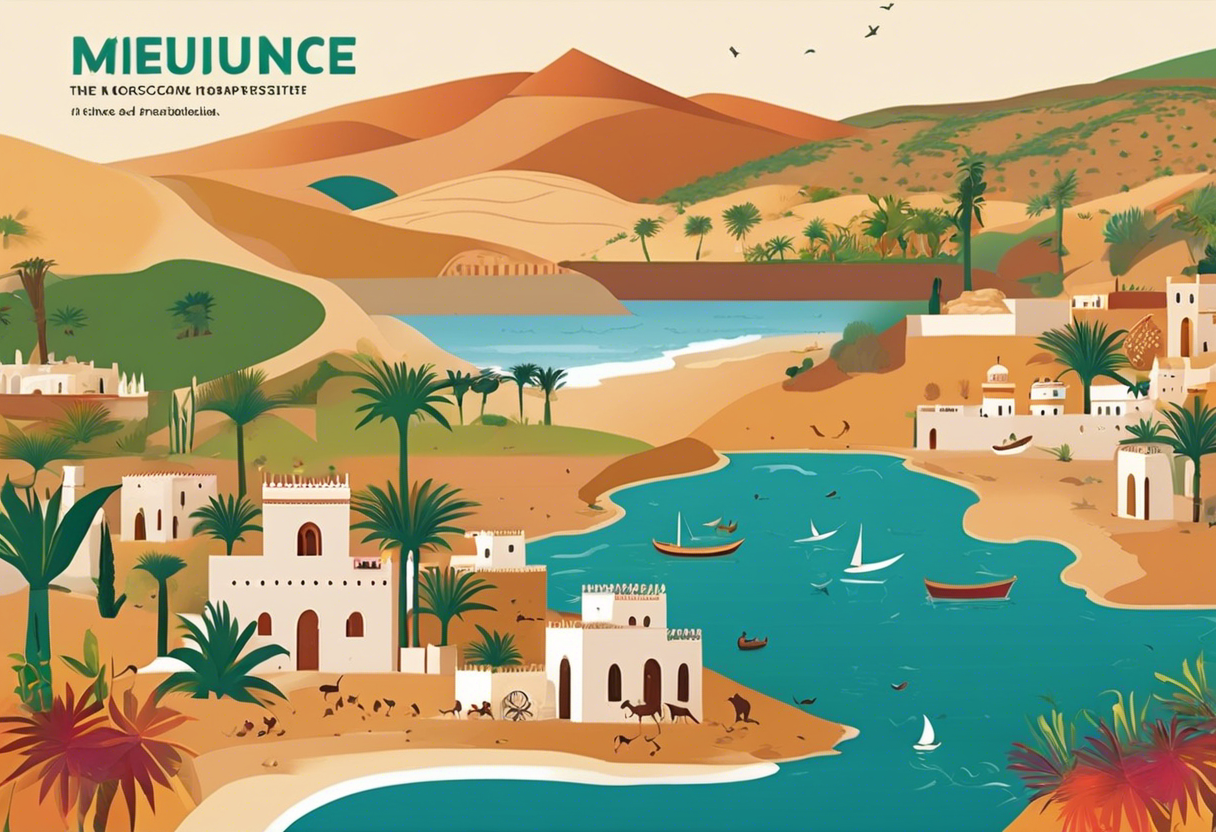
Morocco's rich and diverse cuisine is deeply influenced by its unique geography. Situated on the northwestern tip of Africa, Morocco is a country characterized by its varied landscapes, ranging from the rugged Atlas Mountains to the fertile valleys and coastal plains. This geographic diversity has had a profound impact on the ingredients, cooking techniques, and flavors that define Moroccan cuisine.
1. Proximity to the Mediterranean Sea
The coastal regions of Morocco, with their access to the Mediterranean Sea, have greatly influenced the country's culinary traditions. Seafood, such as fish, shrimp, and calamari, plays a prominent role in dishes originating from cities like Tangier and Essaouira. The combination of fresh fish and the influence of Mediterranean cuisine results in delicacies like grilled sardines, seafood tagines, and a variety of seafood-based soups.
2. The Atlas Mountains and the Influence of Berber Cuisine
The Atlas Mountains stretch across Morocco, dividing the country into different climate zones. This rugged terrain is home to the indigenous Berber people, who have their own distinct culinary traditions. The Berber influence can be seen in dishes like couscous, which is a staple in Moroccan cuisine. The use of earthy spices like cumin, coriander, and saffron, as well as ingredients like lentils, chickpeas, and dates, showcase the rich flavors and ingredients associated with Berber cooking.
3. The Sahara Desert and Nomadic Food Culture
The vastness of the Sahara Desert, which covers a significant portion of Morocco, has shaped the nomadic food culture in the region. Traditional cooking methods, such as tagine cooking, emerged as a practical way of preparing meals in the desert environment. Tagines are slow-cooked stews, traditionally prepared in clay pots, which allow for the retention and concentration of flavors. The scarcity of water in the desert has also led to the development of preserved and dried foods, such as preserved lemons and sun-dried tomatoes, which are commonly used in Moroccan cuisine.
4. Agricultural Oases and the Flavors of Fertile Valleys
Morocco's fertile valleys, created by numerous rivers flowing from the Atlas Mountains, have allowed for the cultivation of a wide range of fruits, vegetables, and nuts. The agricultural oases found in these valleys produce abundant harvests of grapes, olives, dates, oranges, and almonds, among other crops. These ingredients are used in various Moroccan dishes, adding a touch of sweetness, tanginess, or nuttiness to both savory and sweet preparations. Moroccan dishes like tagines filled with dried fruits, fragrant rice with crispy almonds, and pastries with almond and honey fillings are all influenced by the agricultural bounty of the fertile valleys.
Traditional Cooking Techniques in Moroccan Cuisine
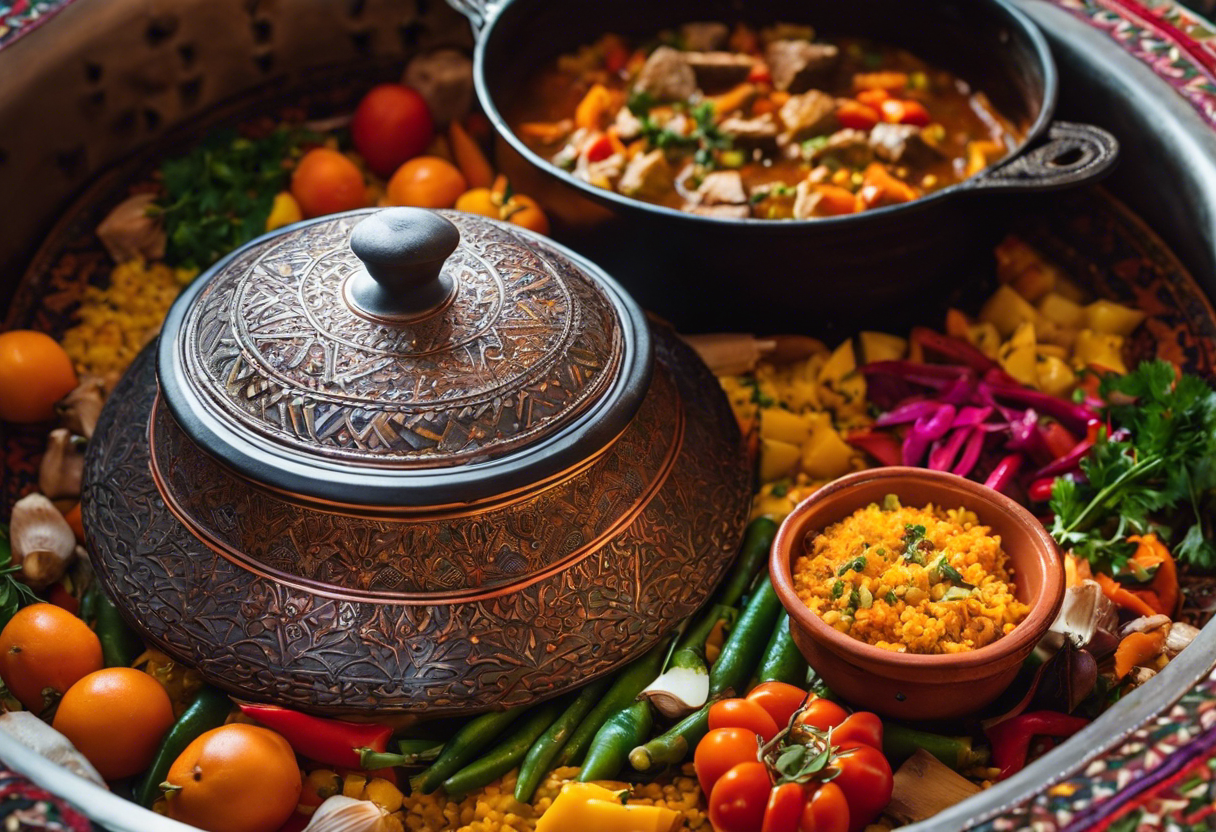
Moroccan cuisine is renowned for its rich flavors and unique cooking techniques that have been passed down through generations. These traditional cooking methods play a crucial role in creating the delicious and aromatic dishes that make Moroccan cuisine so popular worldwide.
- Tajine Cooking Technique: One of the most characteristic cooking techniques in Moroccan cuisine is the use of a tajine. A tajine is a traditional clay or ceramic cooking vessel with a conical lid. The tight-fitting lid helps to retain the moisture and flavors of the ingredients, resulting in tender and flavorful dishes. Tajine cooking involves slow and gentle cooking over low heat, allowing the flavors to meld together beautifully. The tajine is commonly used to prepare stews, tagines, and couscous dishes.
- Preserving with Salt: Preserving food is an important tradition in Moroccan cuisine, especially for fruits and vegetables. One popular technique is to preserve lemons by layering them with salt in a jar. The salt draws out the moisture, creating a juicy and tangy preserved lemon that adds a unique flavor to various dishes like tagines and salads. This technique not only extends the shelf life of the lemons but also enhances the depth of flavor in Moroccan dishes.
- Grilling over Charcoal: Grilling or barbecuing is a widely used cooking technique in Moroccan cuisine. Traditionally, meats and fish are grilled over hot charcoal, which imparts a smoky and charred flavor to the food. Skewers of marinated kebabs or whole fish are cooked over the open flame, creating a perfect combination of tenderness and smokiness. Grilled dishes like kefta (spiced ground meat) and merguez (spicy lamb sausages) are popular among locals and tourists alike.
- Steaming in a Couscoussier: Couscous is a staple in Moroccan cuisine, and the traditional method of cooking it involves the use of a couscoussier, a tall, double-layered pot. The bottom pot is filled with a flavorful broth or stew, while the top pot holds the couscous. As the steam rises from the simmering liquid, it cooks the couscous to perfection, resulting in light and fluffy grains. This method allows the couscous to absorb the fragrant flavors of the broth, enhancing its taste and texture.
- Slow Simmering: Many Moroccan dishes, such as tagines and stews, are cooked using slow simmering techniques. This allows the ingredients to cook gradually over low heat, ensuring tender meat and well-developed flavors. The slow cooking process also allows the spices and herbs to infuse into the dish, creating a harmonious blend of flavors. The result is a hearty and comforting meal that showcases the essence of Moroccan cuisine.
Exploring the Sweet Side of Moroccan Cuisine
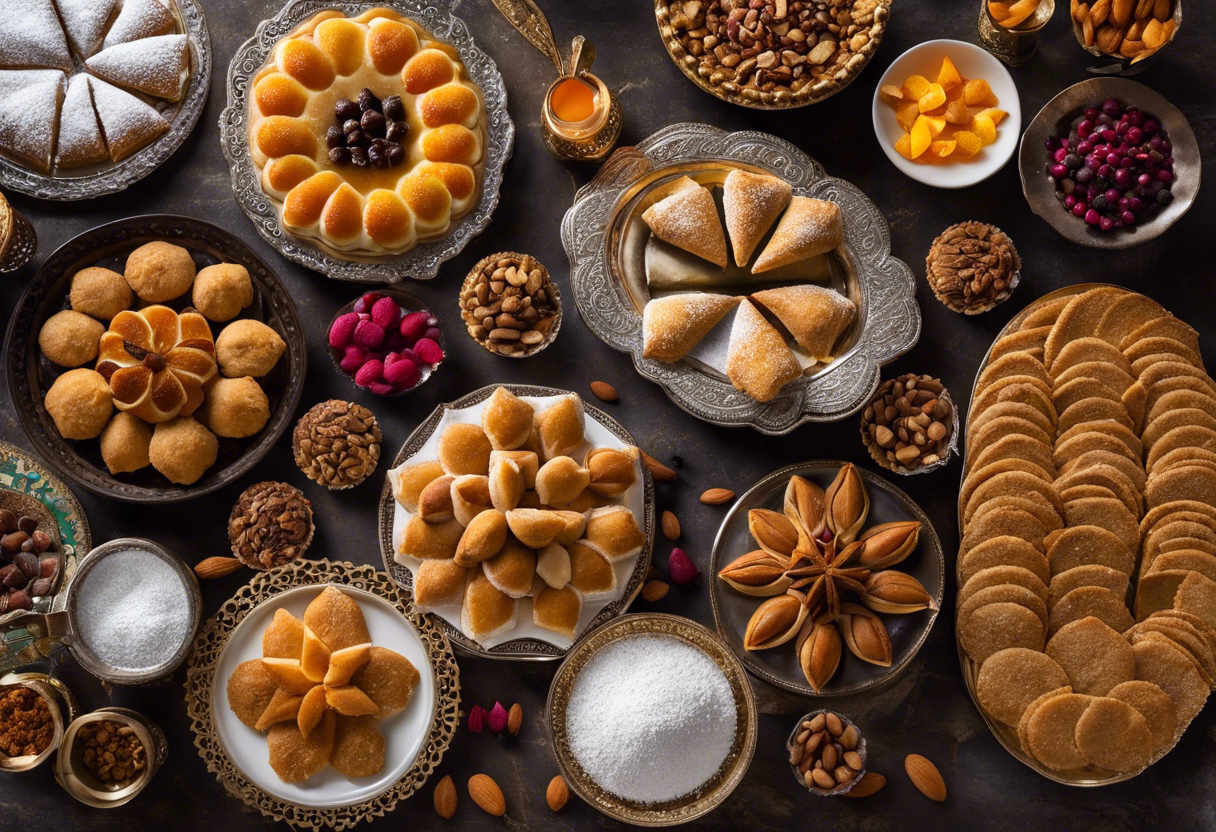
Moroccan cuisine is a treasure trove of vibrant flavors and aromatic spices. While savory dishes often steal the spotlight, the sweet side of Moroccan cuisine is equally captivating. From delicate pastries to rich desserts, exploring the world of Moroccan sweets is a delightful journey for any food lover.
One of the most iconic Moroccan sweets is the famous Moroccan tea cookies known as "ghriba." These delectable treats come in various flavors and textures, from almond and coconut to sesame and pistachio. With their crumbly texture and irresistible sweetness, ghriba cookies are a must-try for anyone with a sweet tooth.
Another beloved Moroccan dessert is "shebakia," which can be described as a type of deep-fried doughnut. The dough is painstakingly woven into intricate shapes, deep-fried until golden brown, and then dipped in honey or syrup infused with orange blossom water. The result is a crispy, sticky, and fragrant treat that is often enjoyed during special occasions and festive gatherings.
Moroccan cuisine is also known for its unique use of spices in desserts. One such example is the "ras el hanout" spiced caramelized oranges. The oranges are first simmered in a fragrant syrup infused with spices like cinnamon, cloves, and star anise, creating a burst of flavors with every bite. This simple yet elegant dessert is a delightful way to end a Moroccan meal.
Rosewater, a common ingredient in Moroccan cuisine, adds a delicate floral note to many Moroccan desserts. One classic dessert that showcases this flavor is "baghrir," also known as Moroccan pancakes. These spongy pancakes are drizzled with a mixture of butter, honey, and rosewater, creating a harmonious blend of sweet and floral flavors. They are often enjoyed for breakfast or as an afternoon treat with a cup of Moroccan tea.
Moroccan cuisine is a beautiful fusion of Arab, Berber, and Mediterranean influences, and its sweet side is no exception. The use of traditional ingredients like almonds, dates, and honey, combined with the artful integration of spices and flavors, creates a unique and captivating dessert culture.
Whether you have a penchant for delicate pastries, sticky sweets, or fragrant desserts, exploring the sweet side of Moroccan cuisine promises a sensory experience like no other. From the first bite to the last, you will be transported to the vibrant streets of Morocco, where the scent of spices and the sweetness of desserts intertwine to create an unforgettable culinary journey
Moroccan Beverage Culture

Morocco is not only known for its delectable cuisine but also for its vibrant beverage culture. Moroccan beverages, infused with aromatic herbs, spices, and fruits, are a perfect complement to the rich flavors of the cuisine. From soothing teas to refreshing fruit juices, here are some of the most popular and traditional beverages enjoyed in Moroccan culture:
- Moroccan Mint Tea: Mint tea, or "atai," is the quintessential Moroccan beverage and a symbol of hospitality. Made by steeping green tea leaves with fresh mint leaves in boiling water, this tea is famous for its refreshing and invigorating taste. It is traditionally sweetened with sugar and poured from a height to create a frothy top layer. Served in small glasses, Moroccan mint tea is a staple in social gatherings and an integral part of Moroccan hospitality.
- Orange Blossom Water: Orange blossom water, or "mazhar," is a fragrant water made from the distillation of bitter orange blossoms. This floral water is often used as a flavoring agent in Moroccan beverages, desserts, and pastries. It adds a subtle floral aroma and a hint of sweetness to beverages like lemonade or iced tea.
- Avocado Milkshake: Avocado milkshake, known as "avocat shake," is a popular drink in Moroccan cuisine. Made with ripe avocados, milk, sugar, and a touch of vanilla, this creamy and indulgent beverage is a delightful treat. It is often served chilled during hot summer days and is enjoyed as a refreshing snack or dessert.
- Spiced Coffee: Moroccan spiced coffee, or "kahwa," is a fragrant and flavorful coffee infused with various spices. Typically made with a strong blend of Arabica coffee, it is brewed with spices like cardamom, cloves, and cinnamon. This aromatic coffee is often served in small cups and accompanied by dates or sweet pastries. It is a beloved beverage during social gatherings and represents Moroccan hospitality.
- Pomegranate Juice: Pomegranate juice, or "nabid ruman," is a refreshing and tangy beverage commonly enjoyed in Morocco. Made from fresh pomegranate fruits, this vibrant red juice is a rich source of antioxidants and is believed to have various health benefits. Served chilled, pomegranate juice is a popular choice during the hot summer months.
Moroccan beverage culture embraces a variety of flavors and traditions. Whether it's sipping on a cup of mint tea, indulging in a creamy avocado milkshake, or enjoying the aromatic spiced coffee, Moroccan beverages offer a unique and delightful drinking experience. These beverages not only quench thirst but also showcase the country's rich cultural heritage and warm hospitality. So, next time you indulge in Moroccan cuisine, be sure to explore the enticing flavors of the country's beverage culture.
The Significance of Hospitality in Moroccan Cuisine

Hospitality is deeply ingrained in Moroccan culture, and it plays a significant role in their cuisine. Moroccan people take pride in their generous hospitality, and this attitude extends to their food traditions. The act of sharing a meal is seen as a way to foster connections, strengthen relationships, and demonstrate warmth and generosity.
Moroccan cuisine is characterized by its rich flavors, aromatic spices, and diverse ingredients. But beyond the tantalizing food itself, the experience of dining in Morocco is one of genuine hospitality that leaves a lasting impression on visitors.
One of the most notable aspects of Moroccan hospitality is the tradition of serving multiple courses during a meal. A typical Moroccan meal starts with a series of small appetizers, known as mezze, which include a variety of salads, dips, and pickled vegetables. These mezze dishes are meant to be shared and enjoyed together, encouraging conversation and camaraderie among diners.
Couscous, a staple dish in Moroccan cuisine, is another example of the significance of hospitality. It is not only a delicious and satisfying meal, but it also represents a sense of community and togetherness. Traditionally, couscous is prepared and served on a large communal platter, with everyone gathering around to partake in the meal. This communal aspect of eating creates a sense of unity and fosters a feeling of belonging.
Moreover, Moroccan hospitality extends beyond the dinner table. The Moroccan tea ceremony, known as nus-nus, is a symbol of friendship and hospitality. The host carefully brews and pours tea in a graceful manner, always offering a second cup. Sipping on this fragrant, mint-infused tea is not only a delightful experience but also a symbol of gratitude and appreciation for the guest's presence.
In essence, the significance of hospitality in Moroccan cuisine goes far beyond the mere act of eating. It encompasses the values of generosity, companionship, and creating an inviting atmosphere. By embracing their culinary traditions, Moroccans welcome guests with open arms, making them feel like part of the family. It is through the power of hospitality that the true essence of Moroccan cuisine is experienced and cherished by all who have the privilege of savoring it.
The Future of Moroccan Cuisine

Moroccan cuisine has a rich history and a diverse range of flavors and ingredients. As the world becomes more interconnected, so does the culinary landscape. Moroccan cuisine is no exception. The future of Moroccan cuisine holds exciting possibilities as it continues to evolve and adapt to contemporary tastes and trends.
Fusion of Traditional and Modern
One of the trends shaping the future of Moroccan cuisine is the fusion of traditional Moroccan flavors with modern cooking techniques and global influences. Chefs are experimenting with new ingredients, methods, and presentations while still honoring the authentic flavors and techniques of Moroccan cuisine. This blending of old and new creates innovative and exciting dining experiences.
Culinary Innovation
Moroccan chefs are pushing the boundaries of traditional cuisine, exploring new combinations of flavors and experimenting with innovative cooking methods. They are turning traditional dishes into works of art, using molecular gastronomy techniques, and incorporating unexpected ingredients. This spirit of creativity and innovation paves the way for new and exciting culinary experiences.
Embracing Sustainability
As the awareness of sustainability and responsible sourcing increases, the future of Moroccan cuisine is likely to embrace eco-friendly practices. Chefs and restaurants are seeking out locally sourced, organic ingredients to reduce their ecological footprint and support local farmers. This commitment to sustainability not only benefits the environment but also adds depth and distinctiveness to Moroccan dishes.
Culinary Education and Preservation
The future of Moroccan cuisine relies on the preservation and promotion of traditional cooking techniques and recipes. Culinary schools and institutes are playing a crucial role in educating the next generation of Moroccan chefs, ensuring that age-old techniques and flavors are passed down. By preserving these culinary traditions, Moroccan cuisine can continue to blossom and captivate palates around the world.
Global Appreciation
Moroccan cuisine is gaining global recognition and appreciation, attracting food enthusiasts from all corners of the world. As more people discover the unique flavors and aromas of Moroccan dishes, the demand for Moroccan cuisine increases. This growing appreciation not only reinforces Moroccan culinary traditions but also encourages the exploration and fusion of Moroccan flavors with other cuisines, leading to exciting new culinary landscapes.
Culinary Tourism
The future of Moroccan cuisine is intertwined with culinary tourism. Travelers are increasingly seeking out authentic culinary experiences, and Morocco has much to offer in this regard. From vibrant souks and street food markets to high-end restaurants and cooking classes, the variety and richness of Moroccan cuisine make it an appealing destination for food enthusiasts. Culinary tourism drives innovation, encourages local culinary talent, and elevates the international reputation of Moroccan cuisine.
In conclusion, the future of Moroccan cuisine is a blend of tradition and innovation, sustainability, global recognition, and culinary tourism. As Moroccan chefs continue to push boundaries and experiment with new flavors and techniques, they ensure the preservation and evolution of their culinary heritage. With its rich history, unique flavors, and vibrant culinary landscape, Moroccan cuisine is destined to captivate palates for many generations to come.

